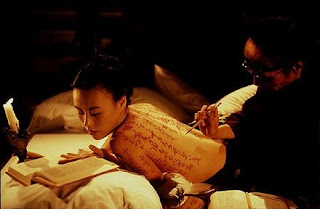Guy Maddin doesn’t make films so much as he projects his dreams on to the screen. His movies exist in world (which presumably finds its nexus inside his strange mind) and in a time period that never really happened; the strange place where silent films have dialogue. Some moviegoers assume that at some point in the history of cinema silent films were simply subtitled as foreign films are today. This was never really the case, but in Maddin’s films it is an actuality. To describe his films is a difficult task, but to do so briefly I can only say that they are just what those misinformed movie lovers believe: silent films that talk.
Most film directors are openly influenced by the generation which directly precedes them. Want to find out where Tarantino comes from? Watch Scorsese. But Maddin seems to find his influences not in Spielberg and Lucas, but in Von Stroheim and Eisenstein. His films all seem thus to have been created in 1929, the birth of the sound era. The dialogue never seems to be in the scene but simply of it; clearly recorded in a booth and dubbed in postproduction. This doesn’t matter. Maddin isn’t going for realism. In fact the only ism he seems to subscribe to is filmism; a love of cinema so true that making his movies any other way would be sacrilege.
His 1990 feature Archangel is no exception to his quirky style. I mentioned Eisenstein, but I feel that Fritz Lang deserves equal credit of influence here. In fact, this movie cries out for a retrospective pitch because it really is “Metropolis (1927) meets Strike (1929).” At the Arctic Circle sits the Siberian city of Archangel. In the midst of World War I its inhabitants and the soldiers stationed there fight off both the Kaiser’s army and the Bolsheviks. A young soldier, Lt. Boles (Kyle McCulloch), has lost his love Iris. She has died but he stills sees her everywhere, especially in the face of another woman, Veronkha, whom he mistakes for his lost love. But Veronkha is married to Philbin, whom she seems to love with hesitance. He might love her as well which would cease most of these complications, were it not for the amnesia which allows him only to remember the early portions of their wedding night. He is stuck in perpetual lack of consummation, in the same way that Boles seems perpetually stuck in melancholia, and for that matter in Archangel.
Because of the plotline of amnesia and a head wound suffered by Lt. Boles, characters in Archangel seem to drift in and out, changing faces and locations. In this way, the film, like all of Maddin’s work, resembles a dream. Things are not definite, they are infinite. Despite the confines of the screen, this world, however unrealistic, seems to go on beyond the borders of the audience’s perception. To Maddin it is as real any piece of cinema verite.
I recommend this piece as the feature portion of a home movie night, viewed after seeing Maddin’s 2000 short The Heart of the World, which A.O. Scott named to his top 10 of that year. If you enjoy the short, you’re sure to have fun with the feature as well. It can be a bit slow in places, but it more than makes up for this pacing issue with style to spare.
Grade: 3 Hats Off












